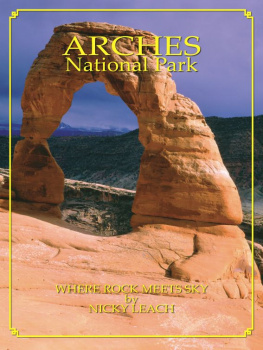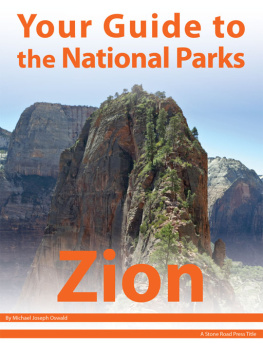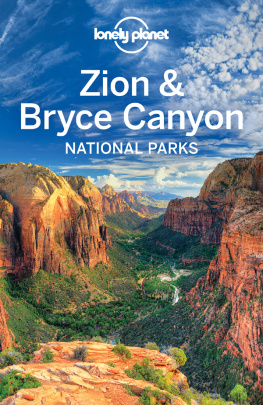ZION NATIONAL PARK
Sanctuary In the Desert
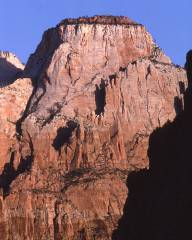
by
Nicky Leach
*****
SIERRA PRESS
Smashwords Edition
Copyright 2010 Sierra Press
*****
Smashwords Edition License Notes
This ebook is licensed for your personalenjoyment only. This ebook may not be re-sold or given away toother people. If you would like to share this book with anotherperson, please purchase an additional copy for each person. Ifyoure reading this book and did not purchase it, or it was notpurchased for your use only, then please return to Smashwords.comand purchase your own copy. Thank you for respecting the hard workof this author.
*****
ACKNOWLEDGMENTS
Thanks to Jeff Nicholas and Sierra Press forasking me to write about my favorite subject; editor Cindy Bohn foranother great blue-pencil job, Denny Davies, Tom Haraden, and thestaff of Zion National Park for taking time to talk with me, checkfacts, and make suggestions; and finally, to Mary Lawrence, a finetravel companion and constant friend.
*****
CONTENTS
*****
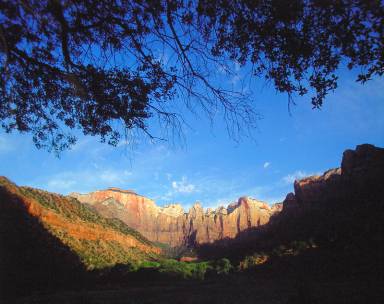
Early morning light on theTowers of The Virgin
It is one of those clarion spring mornings in Zion that comes closeto earthly perfection. A red mackerel dawn sky has limnedRenaissance blue in the full light of day. A whisper of a breezeruffles the new-leafed cottonwoods along the Virgin River and setsthe tall ponderosa pines creaking in their moorings in creviceshigh in the cliffs. Two red-tailed hawks circle lazily on thethermals, then drop out of sight into a huge, desert-varnishedwindow-blind arch in the pale sandstone canyon wall. Mule deerthesoft rustlers at the tent door in the predawn gloomjump daintilyaway on ballerina legs then dart to deeper cover, safe from humaneyes and the hungry gaze of the mountain lion.
Above the valley, the domes, spires, andtemples of Zion seem to raise great angular heads to the heavens,their time-worn, craggy faces streaked and etched by falling waterand year-in, year-out exposure to the weather. "There is aneloquence to their forms which stirs the imagination with asingular power and kindles in the mind," wrote geologist ClarenceDutton in 1880. "Nothing can exceed the wondrous beauty of Zion ... in the nobility and beauty of the sculptures there is nocomparison."
Although it gets all the press, Zion Canyonis just a fraction of a park that might better be described as agiant outdoor museum, preserving some of the world's mostextraordinary geological, archeological, and natural resources. Theheart and soul of Zion, though, is the Virgin River, whose NorthFork rises to the northeast near Cedar Breaks. The river eats itsway through the southern Markagunt Plateau, then confluences withthe East Fork in Zion Canyon downstream from Parunuweap Canyon.From here, it continues down to Hurricane and out of Utah via theVirgin River Gorge, joining the Colorado River in Lake Mead for thelast leg to the Gulf of California. The Southern Paiute call itParus ("whirling water"), but its European name was given in 1776by the Spanish Dominguez-Escalante Expedition, priests whounderstood first-hand the miracle of water in the desert.
After a week exploring Canyon Country's vastspaces, my friend Mary plumped herself down beside the VirginRiver, plunged her toes into the water, and sighed happily. "It'sso cozy here," she said. "I feel safe within these high walls." Iknow what she means. Zion was the first park I ever saw 20 yearsago, and it spoiled me for all others. Nowhere else fills thesenses so completely and begs frequent return visits.
The early morning is comfortably cool as Iset out from camp along the 2-mile Parus Trail, idling amongsagebrush, cactus, and grasses that once provided good grazing forthe cattle of pioneer Mormon ranchers. Tits kafuffle and flap inthe shrubs, and a pair of dippers breasts the river current onspindly but strong legs, looking for insects among the riffles. Ihear a tinkling waterfall of down-lilting notes echo across thecanyon, bouncing from boulder to boulder. Ah, the canyon wren! NowI know I'm home.
The trail passes under the highway bridge,and I walk up onto the deserted scenic drive. The canyon narrowsnoticeably here and the tops of the 7,000-foot formations are lostto view. The Temples of the Virgin, the Beehives, the Sentinel, theThree Patriarchs, the Great White Throne, the Temple of Sinawava.Their names are unforgettable, etched on the memory like lifetimehonorees in Zion's Geological Hall of Fame. Thank an enthusiasticMethodist minister who visited Zion in 1916 for such colorfulmonikers. Today, naming rock-climbing routes is the new name gamein Zion. But the heavenly theme hasn't disappeared. Anyone forSpace Shot today?
Although only a tiny fraction of Utah iscontained within the park, 85 percent of the state's flora andfauna species are found here, including 800 plant species, 289 birdspecies, and 75 mammal species. This can partly be explained by thepark's 4,000- to 9,000-foot elevation span, which takes inlow-desert scrub, mid-elevation chaparral, and subalpine evergreenforests. But there could never be so much life without the presenceof waterand this, Zion has in spades. From the year-round flows ofthe Virgin River to the seeping sandstone cliffs of the canyonnarrows, a remarkable number of living things set up shop andthrive. Some, like the pearl-sized Zion snail of the Zion Narrows,live nowhere else.
The mouth of the Narrows is my finaldestination today. Here the swollen river bursts out of its long,narrow, confined passage into the canyon, in a wet, hissing,slurping, soupy mess of sediment-laden waters that tumble overboulders and continue the river's relentless cycle of depositionand downcutting through 260 million years of sedimentary rocks.It's estimated that the Virgin can continue cutting as much as1,000 feet deeper into its course and maintain its presentgradient. Eventually, though, it will consume the whole plateau,reducing it to a flat, gentle plain. All good things come to anend.
That one little river can achieve so much isremarkable. But with water covering 75 percent of the planet, theodds are definitely in its favor. In a desert where aridity is thedefining characteristic, it is the role of water that lingerslongest in the memory in Zion. The great anthropologist and writerLoren Eiseley once said: "If there is magic in this world, it iscontained in water." I ask the river: Is this true? Yes, says theriver. Yes. Just take a look around.
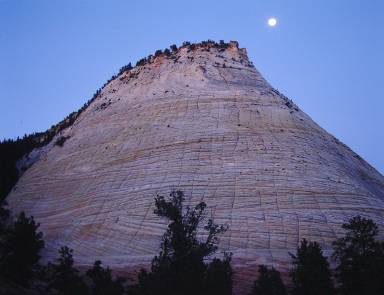
Moonset at sunrise,Checkerboard Mesa
For travelers arriving from the West, viaInterstate 15, Zion National Park is just the first in a tightcluster of remarkable preserved natural and cultural treasuresclustered on the road map. Dubbed the Southwest's Grand Circle,within a 250-mile radius of Zion are 12 national parks, 14 nationalmonuments, seven tribal parks, seven state parks, six nationalforests, and 17 wilderness areas. Nearly all are reachable bypaved, all-weather highways that encircle the Four Corners statesof New Mexico, Arizona, Colorado, and Utah. A word of caution: mostvacationers try to do as much of the Grand Circle as they can andend up rushed and suffering from sensory overload, as sight afterawe-inspiring sight streaks past the car window. To avoid thatindustrial tourist feeling, visit two or three parks and allowtime to stop and smell the sagebrush along the way. Dont worry;youll be back.
Next page

